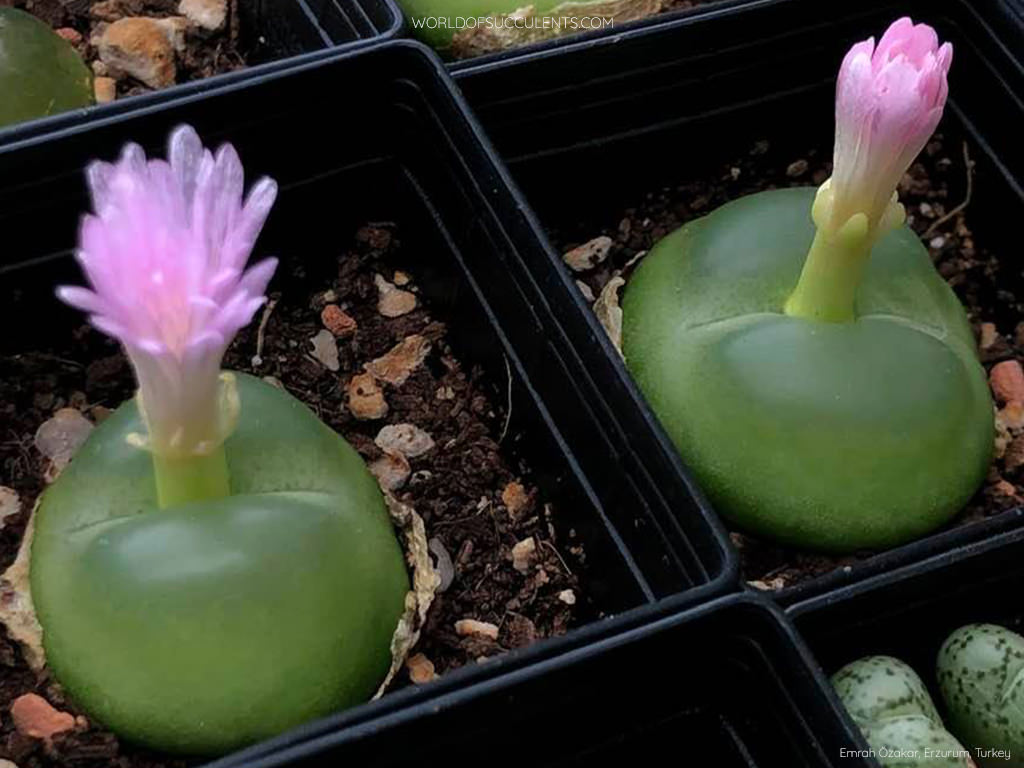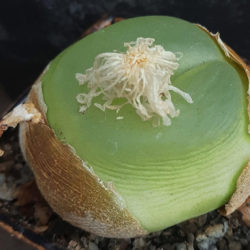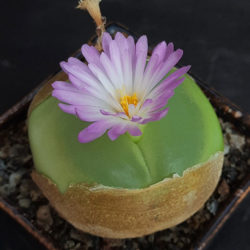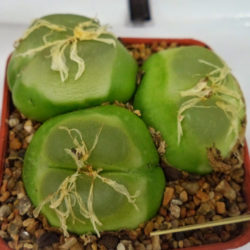Scientific Name
Conophytum ratum S.A.Hammer
Scientific Classification
Family: Aizoaceae
Subfamily: Ruschioideae
Tribe: Ruschieae
Genus: Conophytum
Origin
This species is native to South Africa. It grows embedded in the soil with only the leaf tops exposed to the air in quartz flats at the base of the Gamsberg, Achab se Berg and Namiesberg in the Northern Cape Province.
Description
Conophytum ratum is a small succulent with a jelly-like body composed of two fleshy, windowed, almost entirely fused leaves. It usually remains solitary or rarely forms a group of up to 6 bodies. The bodies are up to 2 inches (5 cm) in diameter and are one of the largest in the genus. The color of the bodies varies from green or yellowish-green during the active growing phase in winter to orange or purple-red in the pre-dormancy phase in early spring. The existing leaves dry up during the dormancy phase and protect the new pair of leaves in a papery sheath. A single daisy-like, usually pink and white flower appears in fall within the center of the body.
Etymology
The specific epithet "ratum (RAY-tum)" is the neuter form of the Latin adjective "ratus," meaning "established" or "fixed."

How to Grow and Care for Conophytum ratum
Light: This succulent needs bright light but does not like too much direct sun. To avoid sunburn, place your C. ratum in a position to receive a few hours of full sun in cooler periods of the day. The plant stretch if it needs more light.
Soil: C. ratum thrives best in porous soil mixes that allow water to drain away quickly. Use a commercial potting mix specially designed for growing succulents or make your own.
Hardiness: High temperatures are not a problem, but the plant can be damaged when the temperature goes below freezing. C. ratum can withstand temperatures as low as 35 to 50 °F (1.7 to 10 °C), USDA hardiness zones 10b to 11b.
Watering: When it goes dormant in the spring, C. ratum requires little or no water. In the fall, when it will begin growing, it is safe to water deeply, allowing the soil to dry before watering again. If leaves start to wrinkle during active growth, your plant needs water.
Fertilizing: This small succulent is a light feeder and does not need fertilizer if it is repotted every two years.
Repotting: The best time to repot C. ratum is at the beginning of the period of active growth, but repotting can be done at almost any time while the plant is actively growing.
Propagation: This species is usually grown from seeds. Like all Conophytums, it is also easily propagated by division. The best time to divide C. ratum is in late summer or early fall, before it begins to break dormancy or after it has flowered. Sow the seeds in fall in a pot with a well-drained soil mix.
Learn more at How to Grow and Care for Conophytum.
Toxicity of Conophytum ratum
C. ratum is non-toxic and safe to grow around children and pets.
Links
- Back to genus Conophytum
- Succupedia: Browse succulents by Scientific Name, Common Name, Genus, Family, USDA Hardiness Zone, Origin, or cacti by Genus
Photo Gallery
Click on a photo to see a larger version.


